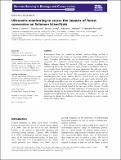Files in this item
Ultrasonic monitoring to assess the impacts of forest conversion on Solomon Island bats
Item metadata
| dc.contributor.author | Davies, Tamara Ellen | |
| dc.contributor.author | Ruzicka, Filip | |
| dc.contributor.author | Lavery, Tyrone | |
| dc.contributor.author | Walters, Charlotte L | |
| dc.contributor.author | Pettorelli, Nathalie | |
| dc.date.accessioned | 2016-06-29T08:30:05Z | |
| dc.date.available | 2016-06-29T08:30:05Z | |
| dc.date.issued | 2016-06 | |
| dc.identifier | 242503910 | |
| dc.identifier | 8da9e53c-088c-4127-b78e-d3b829ed0114 | |
| dc.identifier | 85021324390 | |
| dc.identifier | 000448241100004 | |
| dc.identifier.citation | Davies , T E , Ruzicka , F , Lavery , T , Walters , C L & Pettorelli , N 2016 , ' Ultrasonic monitoring to assess the impacts of forest conversion on Solomon Island bats ' , Remote Sensing in Ecology and Conservation , vol. 2 , no. 2 , pp. 107-118 . https://doi.org/10.1002/rse2.19 | en |
| dc.identifier.issn | 2056-3485 | |
| dc.identifier.uri | https://hdl.handle.net/10023/9060 | |
| dc.description.abstract | Paleotropical islands are experiencing extensive land-use change, yet little is known about how such changes are impacting wildlife in these biodiversity hotspots. To address this knowledge gap, we characterized bat responses to forest conversion in a biodiverse, human-threatened coastal rainforest habitat on Makira, Solomon Islands. We analysed ~200hrs of acoustic recordings from echolocating bats in the four dominant types of land-use on Makira: intact forest, secondary forest, food gardens and cacao plantations. Bat calls were identified to the species level using a supervised classification model (where labelled data are used to train the system). We examined relative activity levels and morphological traits across habitats. Relative activity levels were highest in intermediately disturbed habitats and lowest in the most heavily disturbed habitat, although these differences were not significant. There were significant differences in the mean forearm length of bat assemblages across habitats, with the highest mean forearm length found in the most open habitat (Cacao). Overall, our study constitutes the first detailed exploration of anthropogenic effects on mammalian diversity in the Solomon Islands and includes the first acoustic and morphological information for many bat species in Melanesia. We use our experience to discuss the challenges of acoustic monitoring in such a remote and poorly studied region. | |
| dc.format.extent | 345964 | |
| dc.language.iso | eng | |
| dc.relation.ispartof | Remote Sensing in Ecology and Conservation | en |
| dc.subject | Biodiversity | en |
| dc.subject | Cacao | en |
| dc.subject | Conservation | en |
| dc.subject | Echolocation | en |
| dc.subject | Land use change | en |
| dc.subject | Pacific | en |
| dc.subject | GE Environmental Sciences | en |
| dc.subject | QH301 Biology | en |
| dc.subject | NDAS | en |
| dc.subject | SDG 15 - Life on Land | en |
| dc.subject.lcc | GE | en |
| dc.subject.lcc | QH301 | en |
| dc.title | Ultrasonic monitoring to assess the impacts of forest conversion on Solomon Island bats | en |
| dc.type | Journal article | en |
| dc.contributor.institution | University of St Andrews. Geography & Sustainable Development | en |
| dc.identifier.doi | https://doi.org/10.1002/rse2.19 | |
| dc.description.status | Peer reviewed | en |
This item appears in the following Collection(s)
Items in the St Andrews Research Repository are protected by copyright, with all rights reserved, unless otherwise indicated.

